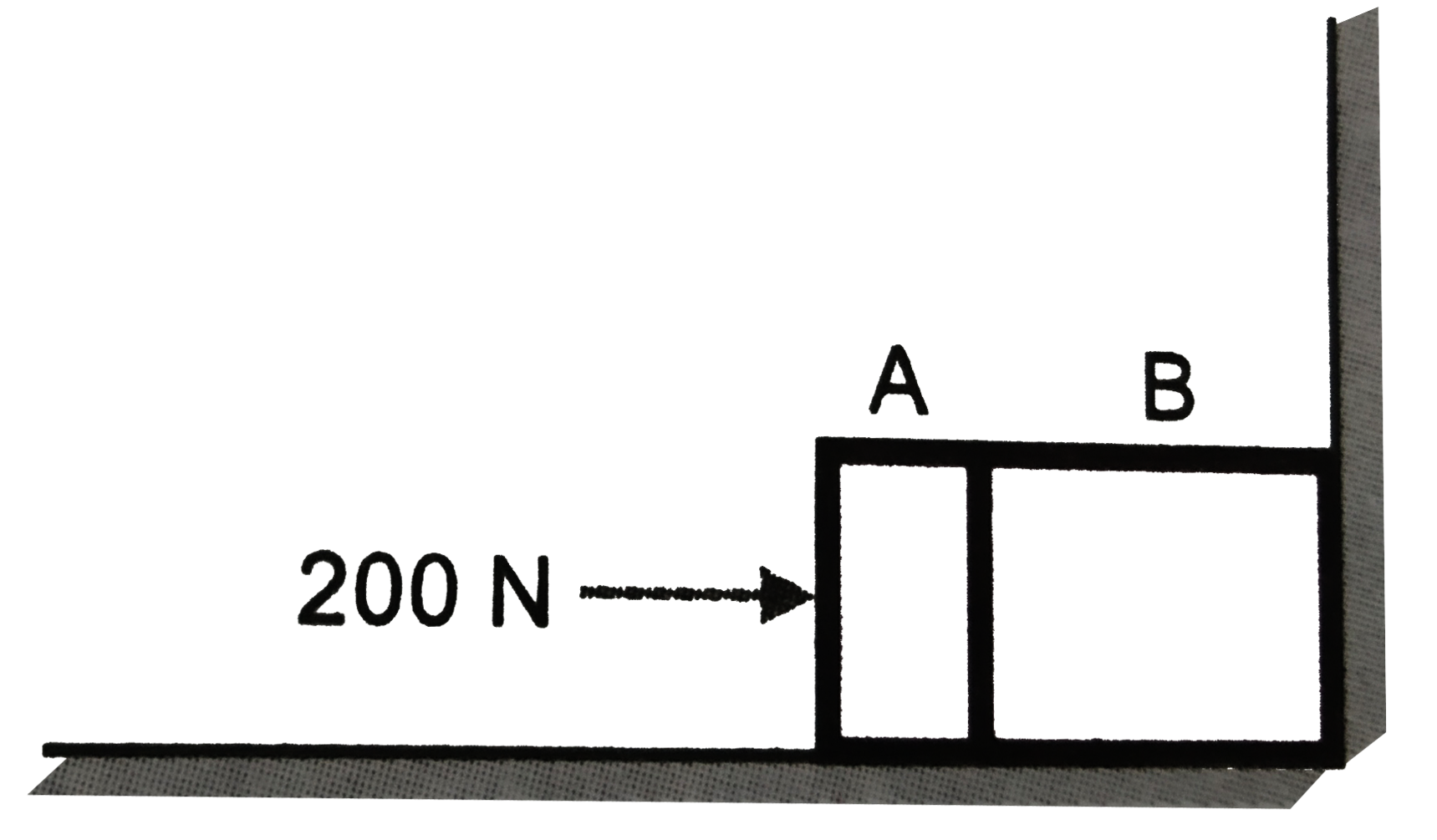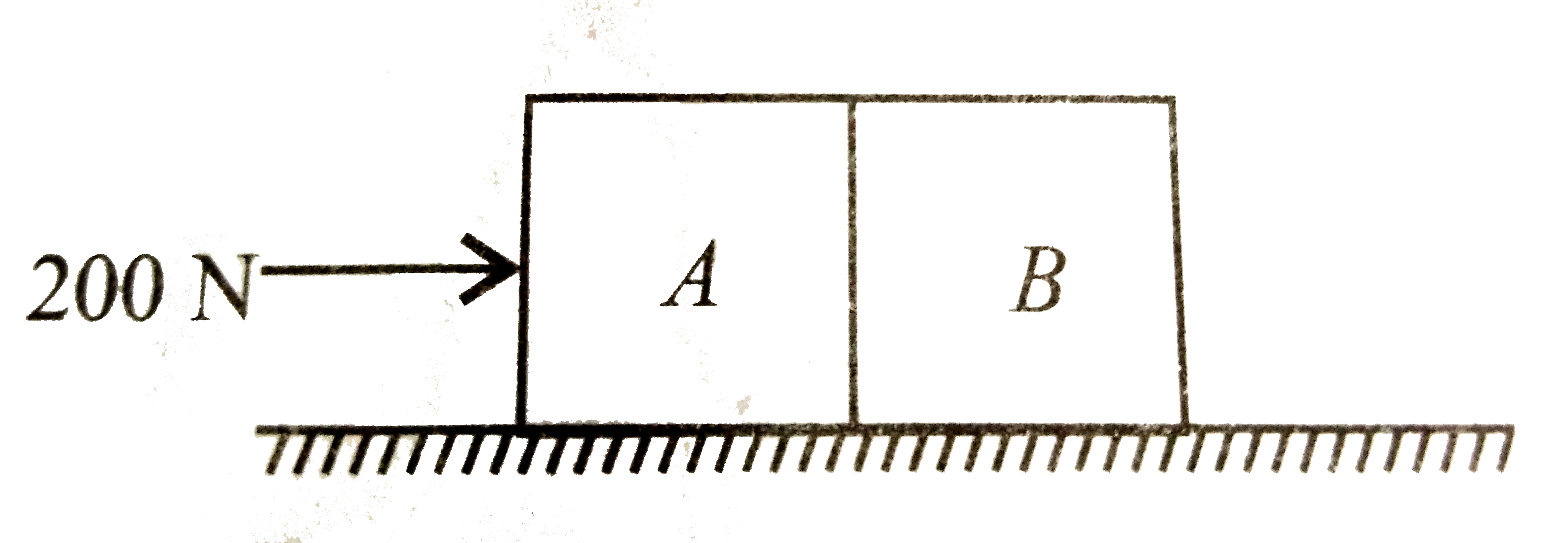Two bodies A,B of masses 5 kg and 10 kg in contact with each other rest on a table against a rigid wall. The coefficient of friction between the bodies and the table is 0.15. A force of 200 N is applied horizontally to A. (i) What is the reaction of the partition? (ii) The actionreaction forces between A,B? (iii) What happens when the wall is removed ? Does the answer to (ii) change when bodies are in motion ? [ Ignore the difference between μs and μk]
We take the round off value g = 10 m.s−2.
Normal reaction on A,
NA=its weight (mg)
=5×10 = 50 N
Normal reaction on B, NB=10×10=100 N
So the limiting friction on A,
fA=μNA=0.5×50=7.5N
and limiting friction on B,
fB=μNB=0.15×100=15 N
[ As the applied force , 200 N, is higher the force of friction attains its limiting value ]
(i) We take the combination of A and B as a single body. It is at rest due to the presence of the wall. If R be the reaction of the wall, the force equation in the horizontal direction is,
200−fA−fB−R=0
or, R = 200 -7.5 -15 = 177.5 N
(ii) Let FAB = action force of A on B, FBA = reaction force of B on A, FAB and FBA are equal and opposite. From the equilibrium of A, we get
200-fA−FBA=0
or, FBA = 200 -7.5=192.5 N
So, FAB=−192.5N
(iii) Now if the wall is removed, the reaction force R is absent due to the applied force the combination of A and B would move forward with an acceleration a (say). Then the force equation in the horizontal direction would be,
200−fA−fB=(mA+mB)a
or, a=200−7.5−155+10=177.515=11.83m.s−2
Now, the force equation for the body A is,
200−fA−FBA=mAa
[FBA= new value of force by B on A]
or, FBA=200−7.5−5×11.83=133.3 N
Similarly, FAB =-133.3 N
So due to the accelerated motion the action-reaction pair changes to a much reduced value.

Topper's Solved these Questions
- FRICTION BOOK - CHHAYA PUBLICATIONCHAPTER - FRICTION EXERCISE - EXAMINATION ARCHIVE with solutions ( JEE Main )
2 Videos
- FIRST AND SECOND LAW OF THERMODYNAMICSBOOK - CHHAYA PUBLICATIONCHAPTER - FIRST AND SECOND LAW OF THERMODYNAMICSEXERCISE - CBSE SCANNER
18 Videos
- HYDROSTATICSBOOK - CHHAYA PUBLICATIONCHAPTER - HYDROSTATICSEXERCISE - CBSE SCANNER
1 Videos
Similar Questions
Two bodies A and B of masses 5 kg and 10 kg in contact with each other rest on a table against a rigid wall as shown in fig. The coefficient of friction between the bodies and the table is 0.15. A force 200 N is applied horizontally to A. What are
(a) the reaction of the partition
(b) the action-reaction forces between A and B ?
(c) What happens when the wall is removed? Does the answer to (b) change, when the bodies are in motion? Ignore the difference between μs and μk

View SolutionTwo bodies A and B of mass 5 kg and 10 kg contact with each other rest on a table against a rigid The coefficient of friction between the bodies and the table is 0.15 A force of 200 N is applied horizontal on A What are (a) the reaction of thee wall (b) the the action , reaction forces between A & B ? What happens when the wall is removed ? Does the answer to (b) Change , when the bodies are in motion ? Ignore differnce between μs and μk
 .
.
View Solution
Knowledge Check
A body of mass 2 kg at rest on a horizontal table. The coefficient of friction between the body and the table is 0.3 . A force of 5N is applied on the body. The force of friction is
A5NB5.88NC6ND20NA body of mass 2kg is at rest on a horizontal table. The coefficient of friction between the body and the table is 0.3 . A force of 5N is applied on the body. The acceleration of the body is.
A0ms−2B2.5ms−2C5ms−2D7.5ms−2Two blocks A and B of masses 10 kg and 15 kg are placed in contact with each other rest on a rough horizontal surface as shown in the figure. The coefficient of friction between the blocks and surface is 0.2. A horizontal force of 200 N is applied to block A. The acceleration of the system is (Take g=10ms−2)
 A4ms−2B6ms−2C8ms−2D10ms−2
A4ms−2B6ms−2C8ms−2D10ms−2
Two bodies A and B of mass 5 kg and 10 kg contact with each other rest on a table against a rigid The coefficient of friction between the bodies and the table is 0.05 A force of 200 N is applied horizontal on A What are (a) the reaction of thee wall (b) the the action , reaction forces between A & B ? What happens when the wall is removed ? Does the answer to (b) Change , when the bodies are in motion ? Ignore differnce between μs and μk
 .
.
View SolutionTwo bodies A and B of mass 5 kg and 10 kg contact with each other rest on a table against a rigid The coefficient of friction between the bodies and the table is 0.05 A force of 200 N is applied horizontal on A What are (a) the reaction of thee wall (b) the the action , reaction forces between A & B ? What happens when the wall is removed ? Does the answer to (b) Change , when the bodies are in motion ? Ignore differnce between μs and μk
 .
.
View SolutionTwo blocks A and B of masses 10 kg and 15 kg are placed in contact with each other rest on a rough horizontal surface as shown in the figure. The coefficient of friction between the blocks and surface is 0.2. A horizontal force of 200 N is applied to block A. The acceleration of the system is (Take g=10ms−2)

View SolutionA block of mass 4 kg is resting on a horizontal table and a force of 10 N is applied on it in the horizontal direction. The coefficient of kinetic friction between the block and the table is 0.1. The work done in √20 s
View SolutionA block A of mass 2 kg rests on another block B of mass 8 kg which rests on a horizontal floor. The coefficient of friction between A and B is 0.2 while that between B and floor is 0.5. when a horizontal force of 25 N is applied on the block B. the force of friction between A and B is
View Solution
